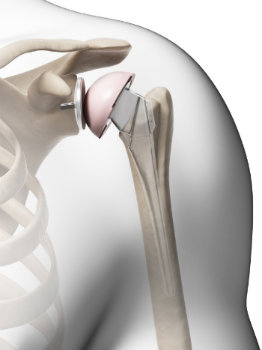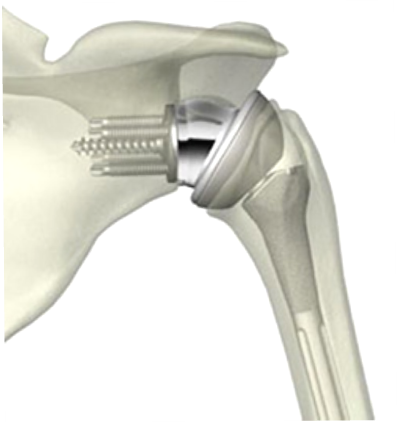



This following provides a brief introduction to shoulder replacement. It can help you make a list of questions to ask your doctor, but it is not meant to provide complete information. Check with your surgeon’s office about more comprehensive resources and patient education materials.
In shoulder replacement surgery, the painful surfaces of the damaged shoulder are resurfaced with artificial shoulder parts. The part that replaces the ball consists of a stem with a rounded metal head. The part that replaces the socket consists of a smooth plastic concave shell that matches the round head of the ball. When both sides of the joint are resurfaced, we call it a total shoulder replacement. However, your doctor may determine that only the humeral side of the joint (ball) should be resurfaced. We call this a partial shoulder replacement.
If you and your surgeon decide that total shoulder replacement is right for you, a date will be scheduled for your surgery. Several things may be necessary to prepare for surgery. For example, your surgeon might ask you to have a physical examination by your primary care physician. This will ensure that other health problems you may have, such as diabetes or high blood pressure, will be treated before surgery. Your doctor, or a staff member, will advise you about the things you can do to prepare for your hospital stay, and your rehabilitation after surgery.
On the day of surgery, an intravenous tube will be inserted into your arm to administer necessary medications and fluid during surgery. You will then be taken to the operating room and given anaesthesia. After the anaesthesia takes effect, your shoulder will be scrubbed and sterilised with a special solution that removes bacteria from your skin.The procedure is performed through an incision over the shoulder that will expose the joint. Special, precision guides and instruments will be used to cut the humeral head (ball) and prepare the bone to accept the implant. The new metal ball and stem are then inserted. If the socket is to be resurfaced, its damaged surface is smoothed and the new plastic surface is inserted. The ball and socket are then joined. When the surgeon is satisfied with the fit and function, the incision will be closed and covered with dressings. A special drain may be inserted into the wound to drain the fluids that naturally develop at the surgical site. The surgery usually takes one to three hours, although this depends on the severity of the arthritis in your shoulder.A sterile bandage will be placed over the wound, and you will be sent to the recovery room where you will be carefully monitored. As the anaesthesia wears off you will slowly regain consciousness. A nurse will be with you, and may encourage you to cough or breathe deeply to help clear our lungs. Your arm will be in a sling or brace, and it may be wrapped in an ice pack to help control pain and swelling. You will also be given pain medication. When you are fully conscious, you will be taken back to your hospital room. Most patients are given anaesthetic block before or after surgery & hence the whole upper limb may be without sensations & sometimes patients are unable to move their fingers. This is expected. The sensations andmovements come back after 12-20 hours.
When you are back in your hospital room, you will begin a gentle rehabilitation programme to help relax the muscles around your new shoulder. On the day of surgery you may be encouraged to get out of bed and take a few steps. You will continue to receive pain medication as needed, and your bandage will be removed about two days after surgery.Depending on your specific situation, you will probably remain in the hospital from one to three days. Your shoulder area may be warm and tender for several weeks. Before you are dismissed from the hospital, your physical therapist will show you how to perform the rehabilitation exercises that are important for your recover.
Successful joint replacement surgery may relieve your pain and stiffness, and may allow you to resume some of your normal daily activities as instructed by your doctor. But even after you have fully recovered from your surgery, you may still have some restrictions. Normal daily activities for shoulder replacement patients do not include contact sports “jamming” activities such as hammering, repetitive heavy lifting, or activities that put excessive strain on your shoulder. Although your artificial joint can be replaced, a second implant is seldom as successful as the first. It is useful to understand that prosthetic joints are not as strong or durable as a natural, healthy joint. Today, total shoulder replacement is becoming a common and predictable procedure. Most patients enjoy relief from pain and improved function, compared to their status before surgery. The rate of wear depends partly on how the shoulder joint is used. Activities that place a lot of stress on the joint implants, as may be the case with more active patients, may reduce the service life of the prosthesis. Implant loosening and wear on the plastic portions of the implant can lead to the necessity for revision surgery to replace the worn components, or all of the components. Your doctor will be in the best position to discuss these issues with you, taking into account your particular clinical circumstances, the type of implants used, and your post-surgical lifestyle. It still means that you must use your operated arm as normally as possible.
Since an artificial shoulder joint has been implanted, it is necessary that you treat your shoulder slightly differently. There will be some movements or activities that may have to be modified. Provided the rotator cuff muscle is in good condition then we
are able to promise the patient an excellent restoration of movement & function. That is exactly why it is better to have the surgery at an optimal or early time before the rotator cuff muscle degenerates severely.
It is very important that you follow your surgeon’s instructions. Any questions should always be discussed with your surgeon before your hospital discharge: